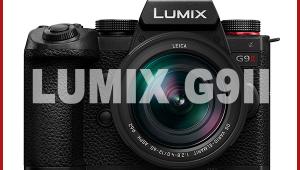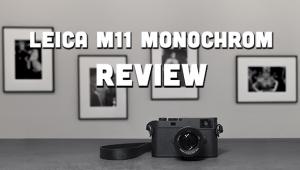Sony’s Alpha NEX-3 Compact System Camera; Interchangeable Lenses, Sweep Panorama & More
At the recent TIPA (Technical Image Press Association) meeting we had an ongoing debate about how to classify cameras like the new Sony Alpha NEX-3. It is certainly not a D-SLR, being mirrorless, yet it does offer interchangeable lenses and even an adapter to use with a Sony D-SLR and compatible lenses, should you want to make this a companion body to your Alpha D-SLR. Like some recent small cameras with interchangeable lenses, the NEX-3’s sensor is equivalent to the APS-C size found in many D-SLR bodies. It has no optical finder, but you can get an optional clip-on Optical Viewfinder in the tradition of rangefinders of the past. It has no built-in flash, but you get an attachable one in the kit. And, if you want enhanced sound for motion clips you can get it with a compatible (and optional) ECM-SST1 stereo mic that fits right atop the camera.
 |
|
|
(The name we came up with for this class of camera, by the way, and which seems most apt for the NEX-3, is Compact System Camera or CSC.)
Did I refer to the camera as small? In the past we have described digital cameras in general, and somewhat tongue in cheek, as microprocessors with lenses. The body of the NEX-3 ($550, with SEL 16mm f/2.8 lens; with SEL 18-55mm f/3.5-5.6 lens, $600) is quite small indeed, at about 4.5x2.5x1.5”, and that 1.5” width is at the small bulge on the handgrip (take off a half inch if you discount the grip). The camera itself weighs next to nothing.
 |
|
 |
|
|
The body, however, is not the issue, as this is an interchangeable lens camera, and that’s where the size issue comes into play. The camera I was sent for testing included the 18-55mm f/3.5-5.6 Optical SteadyShot zoom, which in use becomes the main grip on the camera, being about 3” off the mount long and 2.5” in diameter. (The 16mm, also included in our test kit, is considerably smaller in all respects, making this combo “pocketable” with a bit under 2.5” depth, including lens cap.)
On first blush I really felt like the zoom lens dominated the camera, mainly because the camera itself is so small in hand. I then got used to zooming with the left hand as I worked the controls and release with the right. But all in all, with this combo, I clearly got the feeling that I had mounted a lens to a small, albeit powerful, computer, like a slightly thick cell phone with a large lens up front.
The sensor is APS-C size and is stated as 14.2 megapixels, with file size delivered ranging from 40MB for “straight” shots and around 42MB (depending on the sweep range) for the Sweep Panorama function shots. (More on that later.) Unless you get the optional viewfinder composing is limited to working with the 3” LCD, but I found that this was a little problem as the LCD finder is as bright and snappy as any I’ve seen. The LCD finder does articulate slightly downward, and upward to a perpendicular stance, but not side to side. This aids in eliminating reflections if they become bothersome but more practically allows you to shoot with a more steady stance than with non-articulating LCD monitor cameras, as you can hold the camera in two hands close to your body, à la box cameras of old, and release the shutter with your thumb.
When you look at the camera it is pleasantly buttonless, with an on/off switch, playback button, Movie mode button, and a few other function buttons plus a toggle dial on the back. While design-wise it is nice, it also is a bit disconcerting, as there is no indication of what button does what.
Every function you set is via the LCD and a knurled dial/center activation button that brings you through the shooting options. The small buttons on the top and bottom are unmarked, at least on the body, but when you turn on the menu by slight pressure on the shutter release or touching the center of the knurled control dial, their functions are revealed. The bottom button is sometimes set for “shooting tips,” which can, I suppose, substitute for reading the manual, which is only available on the supplied CD.
 |
|
 |
|
 |
|
|
Heaven forbid I should suggest this, but I do recommend reading the manual and playing with its “interactive” way of bringing you through the instructions. It might just reveal something exciting you didn’t know the camera offered, and could get you out of a potentially frustrating jam. For example, try as I might when I first worked with the camera I could not get it to record a “vertical pan sweep,” although horizontal worked great. I then read the instructions and realized that I had to go into the menu and set the pan direction (it defaults at horizontal left to right) and orientation. Then it worked just fine.
The NEX-3 offers just about every function you’d want, including various Exposure modes, bracketing, exposure compensation, white balance options, etc. Being essentially bereft of the usual dials and buttons, it does take a bit of practice to figure out where the controls for Aperture- and Shutter-Priority, ISO, etc. are set, but that comes quickly enough when you get used to looking at the screen adjacent to the buttons for instructions and not at the buttons themselves, which, on the body at least, are mute.
We’ll see whether this screen ID system, or as the techies say, interface, rather than buttons with markings like WB/DR/ISO with different switches, custom functions, and dials determining how the buttons are utilized will be the design wave of the future. This style is certainly more elegant, at least on the face of it.
While we do not test the video aspects of cameras as we do their still capabilities, the ease of shooting moving pictures makes this a good choice for those who like to include clips in their day’s shoot. The NEX-3 offers 720p HD recording (its slightly more expensive cousin, the NEX-5 offers Full HD/AVCHD files) and MP4 files. If that’s a deal breaker, then choose the NEX-5 (about $100 more with lenses).
 |
|
 |
|
|
- Log in or register to post comments

















































